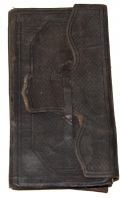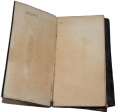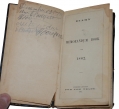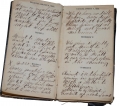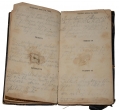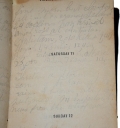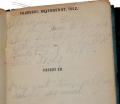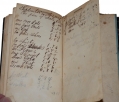site search
online catalog
1861 DIARY OF JAMES A. HUDSON CO. H, FIRST NEW YORK (LINCOLN) CAVALRY
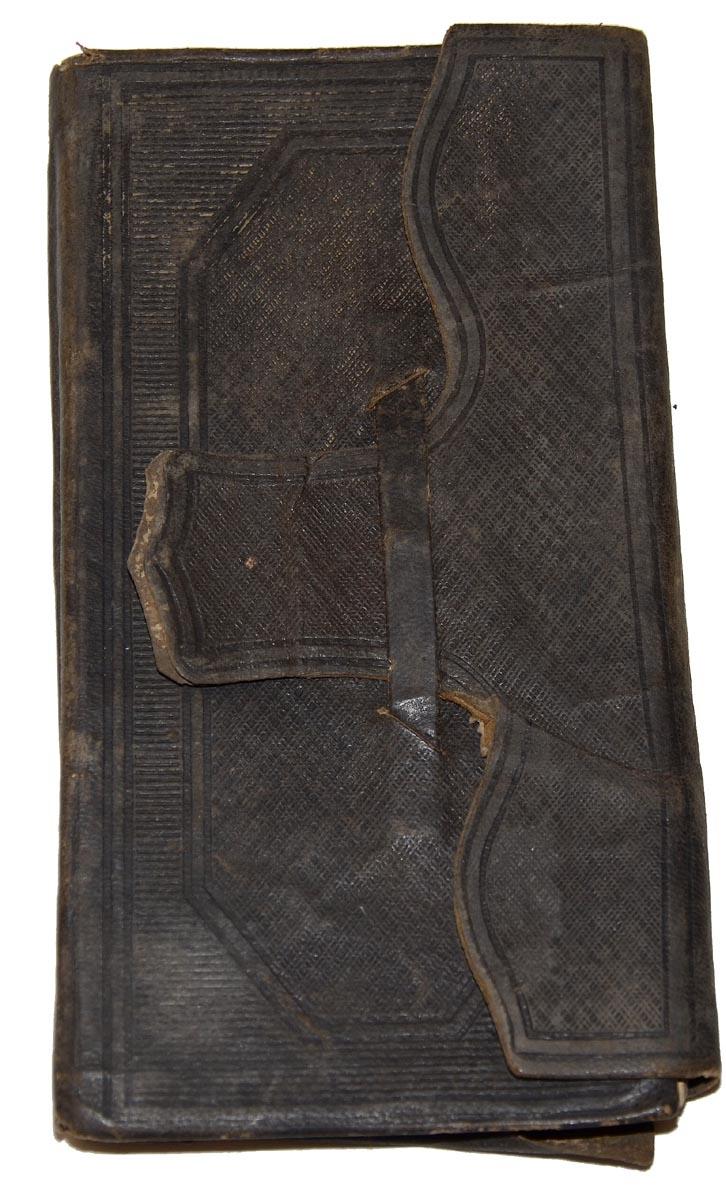
$995.00 SOLD
Quantity Available: None
Item Code: 2020-110
“His executioners (12 in number, one drawn from each company) then stepped forward and shook hands with him. he then told them to do their duty, that he was guilty and his sentence just and with the words God bless you all, he motioned that he was ready. his eyes were then bandaged with a white kerchief the Executioners place pointed out at a distance of 9 paces directly in front of the doomed…”
The First New York, “Lincoln,” Cavalry had an impressive fighting record during its service from 1861 to 1865. Raised on special authorization from President Lincoln when cavalry was in short supply, the regiment mustered in from mid-July to the end of August 1861, fielding nine companies from New York City and environs, one from the Syracuse area, and two more from Philadelphia and Grand Rapids, Michigan. They lost 5 officers and 43 enlisted men killed or mortally wounded and many more wounded in scores of engagements in the Eastern Theatre as part of the Army of the Potomac, Department of West Virginia, Army of the Shenandoah, etc. CWData records an astounding 180 data points where it was engaged and suffered some loss. Phisterer’s New York in the War of the Rebellion has three very densely packed pages recording all the battles, skirmishes and fights in which they took part with or without loss. As the passage cited above shows, however, creation of such a fighting unit was not easy.
This diary was kept by James A. Hudson of Co. H, and runs to about 109 pages in total, from Hudson’s decision to enlist to the end of 1861 Christmas celebrations in camp near Fairfax Seminary. The first 29 pages or so, however, are very light. Hudson was using a diluted ink and there is some staining on the lower inner edge of some pages that may have washed out the writing as well. Fortunately, those pages cover the period before he left New York and the legible portion starts around September 11, when he has reached Washington and is touring the city, and covers the regiment’s development from its arrival in Washington to the end of 1861.
He records in daily entries the organization of the regiment, issues of arms, gear, horses, drills, alarms, reports of skirmishes, reviews and discipline problems as it was pushed forward to the front lines in northern Virginia in Fall 1861 and the federal forces under McClellan tried to regain their footing in the wake of Bull Run.
A few pages of this main portion are light, but it is legible by and large, with good content, and even those light pages can be made out with some patience and a good light. (We have not tried a blacklight on any of the difficult pages.)
James A. Hudson was born in Rockland County in 1841, and was a clerk when he enlisted in New York City on 8/5/61, mustering in as a private in Co. H. The diary records his promotion to corporal on 10/7/61. His service record indicates he mustered out from the regiment after three years of service, on 8/18/64 at Harpers Ferry. After the war he became a lawyer, practiced in NY City, and died in Tarrytown in 1922 at age 81. We include with the diary a pass found folded inside that was made out to Hudson, dated July 1, 1863, at Bedford, PA, passing him to and from town on quartermaster duty.
During this period of organization, discipline, and training of the regiment, they were attached to the defenses of Washington and Alexandria, but furnished men for various patrols beyond the picket lines. In mid-October they were sent over the “Long Bridge” into camps in Virginia, at first being divided between the divisions of Heintzelman and Franklin, and then reunited in mid-November, attached to Kearny’s New Jersey brigade and Franklin’s division near Fairfax Seminary. (At this point the army had not yet been organized into corps or given a distinct cavalry organization.)
Hudson records numerous details of organizing the regiment into battalions, the division of companies into platoons, squads, etc., equipping and arming them (just nine carbines per company, one of which he got,) and the arrival of their mounts. There are several reports of night alarms and skirmishes, along with drills, reviews, problems with forage for the horses, and various mishaps: a man from the company killed by being run over by a wagon, and his own more comic experience: “While on Drill this morning while making a “right parry against infantry” the point of my saber struck an inequality of the ground the blade snapped off 8 or 10 inches from the hilt and wizzing several yds in front of me…”
Most enlightening are accounts of discipline problems in what was considered an elite organization, transferring out fifteen of the toughest cases to other companies, and vignettes of specific incidents: a sergeant returning to camp drunk, thrown in the guard house, released still drunk and then thrown in again for treasonous exclamations and mutiny, who decides to desert; a first sergeant who is left behind dismounted and drunk by the funeral escort he commanded, and returns to be thrown into a ditch by a corporal; even officers who returned to camp, “pretty well fuddled” at 11 pm: “Our Major attempted to play smart and pass the sentinel without giving the countersign but was brought to by a saber thrust through his overcoat, barely missing his side...”A number of the men are named, or their identities would not be hard to figure out.
Hudson also mentions other units. He finds the Anderson Zouaves, for instance, “the roughest set of boys I ever saw, dirty… and half drunk,” and records novel sights, such as men punished by being forced to stand in barrel. Several officers are named. One of his lieutenants was Henry Hidden, killed the following March as the army finally advanced. And several of Hudson’s friends and tentmates are recorded, as are accidents in camp, or sickness.
Two of Hudson’s accounts are secondhand, but from participants. He was sick during the large review attended by Lincoln in November, (though he does mention lolling around in the White House during an earlier tour of Washington.) He reports,
“Lincoln was also present and saluted our cavalry by taking off his hat, bowing, and riding the entire length of our line with his hat in his hand…”
One of the most influential experiences of the regiment was witnessing the execution of one of their own men, William Johnson of Co. D, for attempted desertion and treason in conveying information to the enemy. Johnson had ridden beyond the picket lines, met up with a group he took to be Confederates, and not only wanted to desert to them, told them he had tried before, and gave them information about the Union positions. Unfortunately for him, the men were from the New Jersey brigade. Johnson was tried by court-martial, convicted and shot on Friday the 13th of December, 1861, the first man executed for desertion in the Army of the Potomac. Hudson did not witness it, but provides a graphic account he got from one of the executioners, one man from each company having been selected for the firing squad.
The diary goes right up to and through Christmas Day with the reception of a box from home, lavish Christmas dinner, and an impromptu trip to steal some building materials from neighboring farm buildings loosely guarded by the Irish Brigade.
This diary provides some very interesting insights into the early days of a very well-known regiment.
~~~~~~~~~~~~~~~~~~~~~~~~~~~~~~~~~~~
THIS ITEM, AS WITH ALL OTHER ITEMS AVAILABLE ON OUR WEB SITE,
MAY BE PURCHASED THROUGH OUR LAYAWAY PROGRAM.
FOR OUR POLICIES AND TERMS,
CLICK ON ‘CONTACT US’ AT THE TOP OF ANY PAGE ON THE SITE,
THEN ON ‘LAYAWAY POLICY’.
THANK YOU!
Inquire About 1861 DIARY OF JAMES A. HUDSON CO. H, FIRST NEW YORK (LINCOLN) CAVALRY
For inquiries, please email us at [email protected]
Most Popular
Historical Firearms Stolen From The National Civil War Museum In Harrisburg, Pa »
Theft From Gravesite Of Gen. John Reynolds »
Cavalry Carbine Sling Swivel »
Fine Condition Brass Infantry Bugle Insignia »
featured item
EXTREMELY SCARCE NEW HAMPHIRE OFFICER’S FALSE EMBROIDERED HAT INSIGNIA
Regular army officers had been authorized a silver “U.S.” within a gold bullion wreath for wear on their undress caps in 1839. This was carried over in the 1851 regulations for use on the 1851 shako, but was embroidered directly on the blue band… (2020-912). Learn More »



